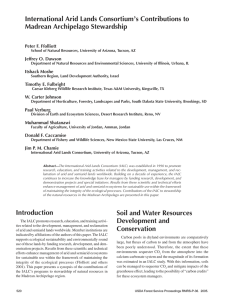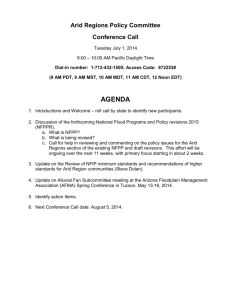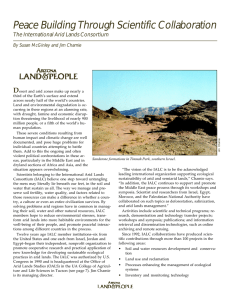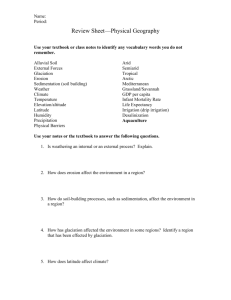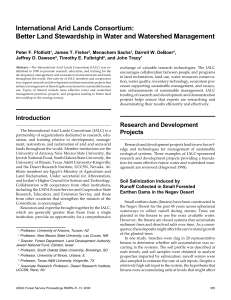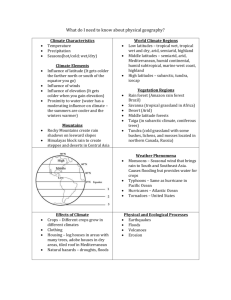Peter F. Ffolliott Jeffrey O. Dawson James T. Fisher Itshack Moshe
advertisement
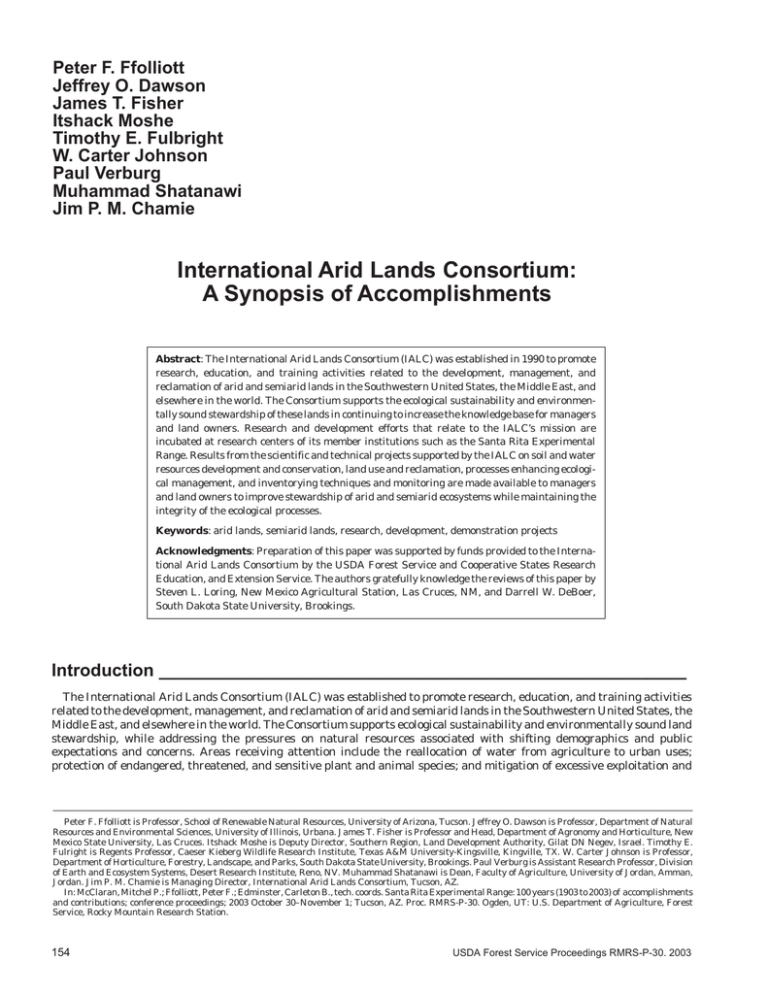
Peter F. Ffolliott Jeffrey O. Dawson James T. Fisher Itshack Moshe Timothy E. Fulbright W. Carter Johnson Paul Verburg Muhammad Shatanawi Jim P. M. Chamie International Arid Lands Consortium: A Synopsis of Accomplishments Abstract: The International Arid Lands Consortium (IALC) was established in 1990 to promote research, education, and training activities related to the development, management, and reclamation of arid and semiarid lands in the Southwestern United States, the Middle East, and elsewhere in the world. The Consortium supports the ecological sustainability and environmentally sound stewardship of these lands in continuing to increase the knowledge base for managers and land owners. Research and development efforts that relate to the IALC’s mission are incubated at research centers of its member institutions such as the Santa Rita Experimental Range. Results from the scientific and technical projects supported by the IALC on soil and water resources development and conservation, land use and reclamation, processes enhancing ecological management, and inventorying techniques and monitoring are made available to managers and land owners to improve stewardship of arid and semiarid ecosystems while maintaining the integrity of the ecological processes. Keywords: arid lands, semiarid lands, research, development, demonstration projects Acknowledgments: Preparation of this paper was supported by funds provided to the International Arid Lands Consortium by the USDA Forest Service and Cooperative States Research Education, and Extension Service. The authors gratefully knowledge the reviews of this paper by Steven L. Loring, New Mexico Agricultural Station, Las Cruces, NM, and Darrell W. DeBoer, South Dakota State University, Brookings. Introduction ______________________________________________________ The International Arid Lands Consortium (IALC) was established to promote research, education, and training activities related to the development, management, and reclamation of arid and semiarid lands in the Southwestern United States, the Middle East, and elsewhere in the world. The Consortium supports ecological sustainability and environmentally sound land stewardship, while addressing the pressures on natural resources associated with shifting demographics and public expectations and concerns. Areas receiving attention include the reallocation of water from agriculture to urban uses; protection of endangered, threatened, and sensitive plant and animal species; and mitigation of excessive exploitation and Peter F. Ffolliott is Professor, School of Renewable Natural Resources, University of Arizona, Tucson. Jeffrey O. Dawson is Professor, Department of Natural Resources and Environmental Sciences, University of Illinois, Urbana. James T. Fisher is Professor and Head, Department of Agronomy and Horticulture, New Mexico State University, Las Cruces. Itshack Moshe is Deputy Director, Southern Region, Land Development Authority, Gilat DN Negev, Israel. Timothy E. Fulright is Regents Professor, Caeser Kieberg Wildlife Research Institute, Texas A&M University-Kingsville, Kingville, TX. W. Carter Johnson is Professor, Department of Horticulture, Forestry, Landscape, and Parks, South Dakota State University, Brookings. Paul Verburg is Assistant Research Professor, Division of Earth and Ecosystem Systems, Desert Research Institute, Reno, NV. Muhammad Shatanawi is Dean, Faculty of Agriculture, University of Jordan, Amman, Jordan. Jim P. M. Chamie is Managing Director, International Arid Lands Consortium, Tucson, AZ. In: McClaran, Mitchel P.; Ffolliott, Peter F.; Edminster, Carleton B., tech. coords. Santa Rita Experimental Range: 100 years (1903 to 2003) of accomplishments and contributions; conference proceedings; 2003 October 30–November 1; Tucson, AZ. Proc. RMRS-P-30. Ogden, UT: U.S. Department of Agriculture, Forest Service, Rocky Mountain Research Station. 154 USDA Forest Service Proceedings RMRS-P-30. 2003 International Arid Lands Consortium: A Synopsis of Accomplishments Ffolliott, Dawson, Fisher, Moshe, Fulbright, Johnson, Verburg, Shatanawi, and Chamie development of limited natural resources. The IALC applies research, development, and demonstration projects, educational and training initiatives, training courses and workshops, and technology transfer activities to the development, management, and reclamation of arid and semiarid lands in the world. Many of these activities are incubated at research centers of its member institutions such as the Santa Rita Experimental Range. Cooperation and Collaboration ___ The Consortium’s member institutions are the University of Arizona, New Mexico State University, the Jewish National Fund, South Dakota State University, the University of Illinois, Texas A&M University-Kingsville, the Desert Research Institute of the University and Community College System of Nevada, Jordan’s Higher Council for Science and Technology, and Egypt’s Ministry of Agriculture and Land Reclamation. Collaboration with cooperators from other institutions, including the USDA Forest Service, the USDA Cooperative State Research, Education, and Extension Service, the U.S. Agency for International Development, and similar institutions worldwide, is also fostered. The IALC brings people and programs together in diverse areas such as water resource development, conservation, and management; soil resource conservation and management; ecosystem processes; land-use planning and decisionmaking, and inventory technology. Accomplishments and Contributions __________________ Illustrative IALC’s accomplishments and contributions are presented in this paper through a synopsis of the research, development, and demonstration projects and initiatives grouped into the categories of soil and water resources development and conservation, land use and reclamation, processes enhancing ecological management, and inventorying techniques and monitoring. A more detailed review of the Consortium’s accomplishments and contributions is presented in a 10-year review of its history by Ffolliott and others (2001). Soil and Water Resources Development and Conservation The IALC orients its efforts in soil and water resources development and conservation to help people understand what causes losses in soil productivity and to synthesize methods to reclaim degraded soil and water resources. Results from these efforts provide managers and land owners with ways to overcome existing or anticipated limitations in soil and water resources. For example, while the role and importance of arid and semiarid land soils in carbon sequestration are not fully known, management agencies are being pressed to report management impacts on carbon flows and strategies potentially useful to offset carbon emissions. The Consortium’s efforts have contributed fresh insights and innovated analytical tools for addressing this USDA Forest Service Proceedings RMRS-P-30. 2003 crucial issue in terms of evaluating management impacts and formulating management strategies for this purpose. Conserving potable water for critical uses is an important water supply issue. Managers and land owners must understand the associated agricultural crop and environmental health risks posed by the water that is locally made available including treated waste water. IALC research has also extended people’s knowledge of water and integrated watershed management (Ffolliott and others 2000) and the physical-chemical processes that lead to the contamination of water systems in arid and semiarid regions. Land Use and Reclamation A main thrust of the IALC research and development projects in land use and reclamation concerns is developing computer-based systems to improve decisionmaking processes for desert, grassland, and riparian ecosystem management efforts. Managers of these fragile ecosystems generally confront problems that involve several goals and objectives. One such problem can be minimizing the cost of a water management practice while maximizing forage production, with this problem also subject to limited funding, a restricted land base, and a requirement to satisfy the objectives within a specified period. Managers can effectively analyze this type of resource-allocation problem with decision-support systems such as those developed by researchers supported by the IALC. While the themes of these systems have largely centered on plant-water relationships, optimizing livestock stocking rates, and habitat suitability, the general structure of the decision-support systems that have been developed are applicable to a wide spectrum of management topics. A database template based on knowledge gained on research centers such as the Santa Rita Experiment Range has been developed for rangeland managers to build their own local database systems for planning effective and environmentally sound livestock management practices on public grazing lands in the Southwestern United States. These databases also help researchers to validate predictive models of forage growth and consumptive patterns, teachers and students to learn about the ecological processes of livestock production, and decisionmakers to select the best rangeland management practice. Processes Enhancing Ecological Management The IALC research and development activities help people to determine how livestock grazing, invasive shrub control, reseeding activities, and microphytic soil crust occurrences influence plant rangeland diversity, nutrient distribution and productivity, and water capture. The high proportion of the IALC studies relating to biological diversity and productivity of plants and animals, and their functional relationships, reflects the fragility of biodiversity in arid and semiarid land ecosystems. The Consortium has also supported research on genetic and physiological determinants of drought hardiness and the productivity of coniferous trees, fruit-producing cacti, and native herbaceous 155 Ffolliott, Dawson, Fisher, Moshe, Fulbright, Johnson, Verburg, Shatanawi, and Chamie plants. Results from these studies provide a basis for selecting, breeding, or genetic modification of plants that tolerate aridity and prolonged heat loads. The improved understanding of genetic diversity and phenotypic plasticity is helping to predict the effects of global climate change and habitat destruction on populations of plants and associated organisms. Efforts supported by the IALC contribute to people’s understanding of how habitat fragmentation, livestock grazing patterns, and herbaceous and shrub invasion affects species diversity and the ecology of desert fauna. The contributing role of small mammals in soil-patch development and maintenance has also been clarified. Studies on ungulates have centered on anti-nutritional factors in leguminous shrubs and development of telemetry to track animals. The effects of landscape-level processes such as habitat fragmentation and desertification on ungulate and predator diversity and population dynamics have also been addressed. Inventorying Techniques and Monitoring IALC-supported projects in inventorying and monitoring have focused on developing improved ways to assess the risk that humans pose to the fragile ecology of arid and semiarid environments and, conversely, the hazards that these environments pose to humans (Ffolliott and others 1998, 2001). Research and development that involve the impact of human activities on the environment largely consider the response of vegetative systems to traditional land uses including livestock grazing and agroforestry activities. However, researchers have learned that field-based inventorying and monitoring are often unable to detect subtle changes in landscape conditions caused by these actions, a situation necessitating continued study. Intensive inventorying and monitoring of small areas are not necessarily representative of the overall condition of the larger landscape. Therefore, techniques have been developed to provide a wide spatial assessment of land surface conditions that are compatible with temporal data sets that represent decades or longer. Geographic information systems play a major role in these research and development activities. 156 International Arid Lands Consortium: A Synopsis of Accomplishments The Future ____________________ Where technologically based economic development and urbanization supplants pastoralism and other traditional land uses of arid and semiarid lands, problems of livestock overgrazing, ineffective water conservation, excessive recreation impacts, unwise mining operations, and pollution continue to emerge. Solutions to these problems require careful research and planning to improve the critical balance between humans and their natural resource systems. Efforts to restore and preserve natural and cultural heritage, sustain intensive agricultural enterprises, and maintain biological diversity must be increased. The consequences of overpopulation and resource degradation are dire and, as a result, will challenge political, economic, and scientific leaders. Therefore, the future requires the IALC to be flexible and innovative in meeting its mission. Policies and approaches that increase collaboration must continue. Member institutions will continue to cooperate, collaborate, and contribute within a framework of shared interest in, and concern for, the viability of arid and semiarid ecosystems worldwide. References ____________________ Ffolliott, P. F.; Fisher, J. T.; Sachs, M.; DeBoer, D. W.; Dawson, J. O.; Fulbright, T. E. 1998. Role of demonstration projects in combating desertification. Journal of Arid Environments. 39: 155–163. Ffolliott, P. F.; Fisher, J. T.; Sachs, M.; DeBoer, D. W.; Dawson, J. O.; Fulbright, T. E.; Tracy, J. 2000. International Arid Lands Consortium: Better land stewardship in water and watershed management. In: Ffolliott, P. F.; Baker, M. B., Jr.; Edminster, C. B.; Dillon, M. C.; Mora, K. L., tech. coords. Land stewardship st in the 21 century: the contributions of watershed management. Proc. RMRS-P-13. Fort Collins, CO: U.S. Department of Agriculture, Forest Service, Rocky Mountain Research Station: 335–338. Ffolliott, P. F.; Dawson, J. O.; Fisher, J. T.; Moshe, I.; DeBoer, D. W.; Fulbright, T. E.; Tracy, J.; Al Musa, A.; Johnson, C.; Chamie, J. P. M. 2001. Arid and semiarid land stewardship: a 10-year review of accomplishments and contributions of the International Arid Lands Consortium. Gen. Tech. Pap. RMRS-GTR-89. Fort Collins, CO: U.S. Department of Agriculture, Forest Service, Rocky Mountain Research Station. 74 p. USDA Forest Service Proceedings RMRS-P-30. 2003
